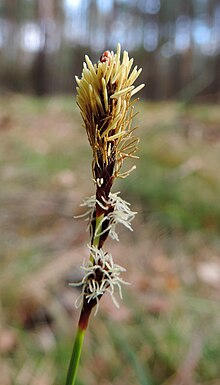Heather sedge
| Heather sedge | ||||||||||||
|---|---|---|---|---|---|---|---|---|---|---|---|---|

Illustration of the bird's foot sedge ( Carex ornithopoda ) (left) and the heather sedge ( Carex ericetorum ) (right) |
||||||||||||
| Systematics | ||||||||||||
|
||||||||||||
| Scientific name | ||||||||||||
| Carex ericetorum | ||||||||||||
| Pollich |
The heather sedge ( Carex ericetorum ) is a species of sedge ( Carex ) native to Central Europe . It is a variegated sedge.
description
The heather sedge is a perennial plant and forms runners. It becomes 10 to 30 cm high. The stems are bluntly triangular and slightly rough. The leaves are evergreen. They are up to 2 mm wide, dark green and about the same length as the stem. The basal sheaths are yellow-brown, sometimes tinged with purple; they are not fibrous.
There are one to three female spikelets . They are dense, sessile and erect. There is a male spikelet. The lowest bract is dry-skinned and broadened at the base. It has almost no sheath and does not usually protrude beyond its spikelet. The bracts are blunt, broadly obovate, dark red-brown and with a white dry skin margin. A median strip is missing, at the front end the bract is often fringed ciliate. The stylus has three scars . Flowering time is March and April.
The fruit is 2 to 2.5 mm long, hairy. It is obovate to spherical. The beak is short, two-toothed and trimmed.
The number of chromosomes is 2n = 30 or 60.
distribution
The heather sedge is native from Europe to Mongolia and is a plant that occurs in submeridional-montane to boreal, continental climates. In Germany it is scattered, rare in the southwest and widespread in the northeast. In the Allgäu Alps, it rises in the Tyrolean part between Oberellenbogen and the Elbognerspitze up to 1540 m above sea level.
It grows in subcontinental heaths and dry pine forests. In Central Europe it is a character species of the Pyrolo-Pinetum from the Cytiso-Pinion association, but also occurs in societies of the Erico-Pinion association, in the eastern areas also in the Genistion association and in the Elynetum in the central Alps.
literature
- Rudolf Schubert , Klaus Werner, Hermann Meusel (eds.): Excursion flora for the areas of the GDR and the FRG . Founded by Werner Rothmaler. 13th edition. tape 2 : vascular plants . People and knowledge, Berlin 1987, ISBN 3-06-012539-2 (area).
- Siegmund Seybold (Ed.): Schmeil-Fitschen interactive . CD-ROM, version 1.1. Quelle & Meyer, Wiebelsheim 2002, ISBN 3-494-01327-6 .
Individual evidence
- ↑ a b Erich Oberdorfer : Plant-sociological excursion flora for Germany and neighboring areas . With the collaboration of Angelika Schwabe and Theo Müller. 8th, heavily revised and expanded edition. Eugen Ulmer, Stuttgart (Hohenheim) 2001, ISBN 3-8001-3131-5 , pp. 185 .
- ↑ Rafaël Govaerts (ed.): Carex ericetorum. In: World Checklist of Selected Plant Families (WCSP) - The Board of Trustees of the Royal Botanic Gardens, Kew . Retrieved October 18, 2016.
- ↑ Erhard Dörr, Wolfgang Lippert : Flora of the Allgäu and its surroundings. Volume 1, IHW, Eching 2001, ISBN 3-930167-50-6 , p. 263.
Web links
- Heather sedge. In: FloraWeb.de.
- Heather sedge . In: BiolFlor, the database of biological-ecological characteristics of the flora of Germany.
- Profile and distribution map for Bavaria . In: Botanical Information Hub of Bavaria .
- Carex ericetorum Pollich In: Info Flora , the national data and information center for Swiss flora .
- Distribution in the northern hemisphere from: Eric Hultén, Magnus Fries: Atlas of North European vascular plants. 1986, ISBN 3-87429-263-0 at Den virtuella floran. (swed.)
- Thomas Meyer: Data sheet with identification key and photos at Flora-de: Flora von Deutschland (old name of the website: Flowers in Swabia )
